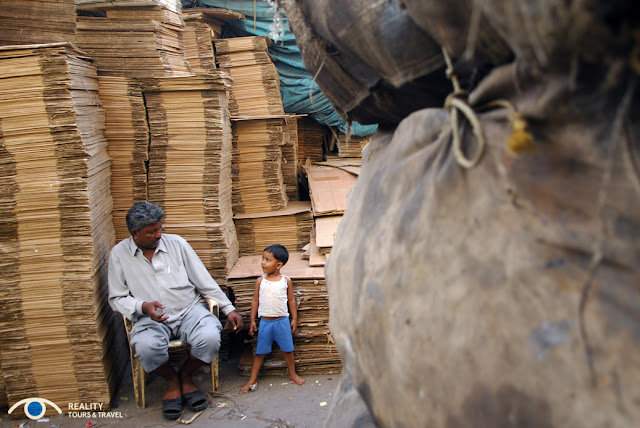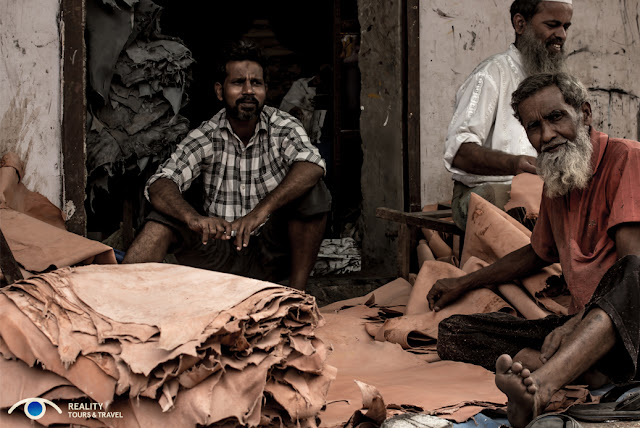 |
| Courtesy of Reality Tours |
If you've ever flown into Mumbai you'll know that there's no avoiding the third largest slum in the world, Dharavi, a sprawling mass of corrugated tin, cardboard and blue tarpaulin running alongside the international airport. Spanning more than 550 acres with a population of over a million people, an average of 15,000 of them share a single toilet, infectious diseases such as dysentery, hepatitis and malaria are rife and there are no hospitals. Many visitors choose to look the other way, disgusted by the perceived squalor and poverty.
| Chowpatti Beach, Mumbai (January, 2016) |
After reading Shantaram, Gregory David Roberts' stupendous semi-autobiographical novel I was captivated by the tales of protagonist Lin's time in Dharavi and watching Slumdog Millionaire years later only served to increase my interest. On the many occasions we've visited Mumbai we've seen the children of Dharavi enjoying themselves on Chowpatti beach and heard the squeals of delight from the rooftop kite fliers when we've driven past the slums but never thought of venturing inside.
| We're on the train! |
When I first heard about slum tours I thought they sounded rather tasteless, imagining over-privileged Westerners ogling the living conditions and poverty of those much less fortunate from the comfort of an air conditioned car. How wrong I was! Reality Tours are award-winning, ethical tour company run by the residents of Dharavi with 80% of the profits going back into the community.
| Churchgate Station |
Joined by Brit couple, Tim & Annie, Emmanuel from Marseilles and Lucy from Paris we met a representative from Reality Tours at Churchgate railway station and were accompanied on the train to Mahim (the closest station to Dharavi). On disembarking we were introduced to our guide, graduate Raj, who had moved here with his family from Goa as a child. Together we crossed the railway bridge and entered Dharavi for a two-and-a-half walking tour.
 |
| Courtesy of Reality Tours |
Despite the poverty Dharavi has been described by the Observer as "One of the most inspiring economic models in Asia". Hidden amongst the maze of dilapidated shacks and alleyways so narrow you occasionally have to walk sideways, are around fifteen thousand single-room factories employing around a quarter of a million people and turning over an estimated £700 million annually.
Most of the small businesses in Dharavi are based on waste recycling. Slum dwellers of all ages scavenge waste materials from across Mumbai and haul them back in enormous bundles for reprocessing. Aluminium cans are smelted down, soap scraps from schools and hotels are reduced in massive vats, leather is reworked, unwanted oil drums are scrubbed and repainted and waste plastics are broken down and remoulded. I'll never forget one man rinsing out a mountain of Head and Shoulders shampoo bottles and shuddering at the ridiculous amount of waste plastic us humans create.
Over ten thousand are employed in the recycled plastic sector.
Ranging from three thousand to fifteen thousand rupees a month, wages are well above the national average and although Dharavi has no health centre it does have banks and an ATM.
 |
| Courtesy of Reality Tours |
Reality Tours ask that visitors refrain from taking photos, although we were given permission to take a few pictures from the plastic sector roof, after being the subject of about a million selfies in Gujarat I could completely understand this. Most of the photos I've used in this post were either emailed to us from Reality or scanned from a set of postcards I bought from their head office.
 |
| Courtesy of Reality Tours |
Don't expect Dharavi to be all abject poverty, depression and deprivation. Unlike the favelas we encountered when we visited Brazil, here the atmosphere is positive, friendly and industrious. Every day up to five hundred economic refugees arrive in Mumbai, often escaping a life of crushing rural poverty. Most new arrivals have to sleep on the streets, to find a home in the slum is a step up the ladder.
 |
| Courtesy of Reality Tours |
At every tiny workshop we passed we were greeted with welcoming smiles, namastes and cheerful waves. Raj seemed to know everyone. We'd ask what they were up to and he'd translate, bringing out everything from colourful plastic vegetable racks and bathroom tidies, wheelie suitcases, exquisitely tailored waistcoats, rotis and poppadums and probably some of the most gorgeous quality leather bags I've ever set my eyes on (find them HERE).
 |
| Courtesy of Reality Tours |
I chatted to the manager of the leather shop and was delighted that, after I mentioning where we was from, he told me that Walsall was home to the finest quality leather in the world. If you're wondering, the leather produced in India comes from buffaloes and not the holy cow!
 |
| Courtesy of Reality Tours |
Among the first to make Dharavi their home were the Kumhar (or potters) caste, originally from Gujarat.
 |
| Courtesy of Reality Tours |
While we stopped to admire a large number of freshly made pots drying in the sunshine a large ginger tom decided to walk straight through them, causing two to topple over and disintegrate. That's the twenty-first pot he's broken this week, one of the potters told us, picking the cat up, placing it on his lap and lavishing him with love.
 |
| Courtesy of Reality Tours |
And what of the living conditions within the slum? Homes consist of two single rooms, one on top of the other, with the upper storey accessible by a ladder on the outside. An entire family live in one room with cooking, sleeping and living all taking place in that single space.
 |
| Courtesy of Reality Tours |
Those rooms are immaculate with scrubbed floors and highly polished tin cookware neatly stacked on the shelves.
 |
| Courtesy of Reality Tours |
Running water is available to Dharavi residents for just an hour twice a day and is saved in large plastic vats stored outside each home.
 |
| Courtesy of Reality Tours |
There's tiny hole-in-the-wall snack bars and tea stalls, barbers shops, fruit and veg vendors and corner shops.
 |
| Courtesy of Reality Tours |
Wherever we went bright-eyed, barefoot children would greet us, some high-fiving us & shaking hands, others shyly following us and running off giggling when we said hello. Outside one house were three little boys each grooming a tiny white kitten, they were thrilled to bits when I went over to look, excitedly offering me each pet in turn to kiss.
 |
| Courtesy of Reality Tours |
The profits from the slum tours are ploughed back into Dharavi, funding education & recreational facilities for both boys and girls and have also built a community centre for residents of all ages to use.
 |
| Courtesy of Reality Tours |
Although I didn't take these photos, the smiles we encountered on our tour were no different.
 |
| Courtesy of Reality Tours |
 |
| Courtesy of Reality Tours |
 |
| Courtesy of Reality Tours |
Raj told us that moving to Dharavi was the best thing his family had ever done, the community was strong and supportive and it was impossible to feel sad or lonely with so many friends around. After the warm welcome we were given it made us reflect on who was actually better off, us Westerners with all our home comforts and space or the slum dwellers who existed in a single room with no running water but surrounded by people who cared for them.
 |
| Courtesy of Reality Tours |
Reality Tours run walking tours for groups of six or less at 9.15 am and 12.45 pm daily.
Cost is 900 rupees per person (approx.£10) including return train tickets. More information can be found HERE.
If you've been reading my blog for a while you'll know how much Jon & I love Mumbai, the mere mention of the place gives me butterflies. The Slum Tour is honestly one of the most uplifting experiences we've ever had.







